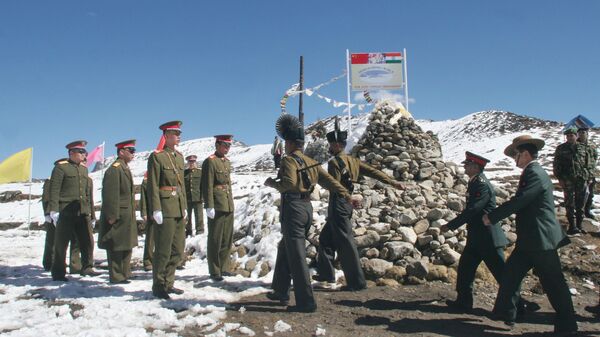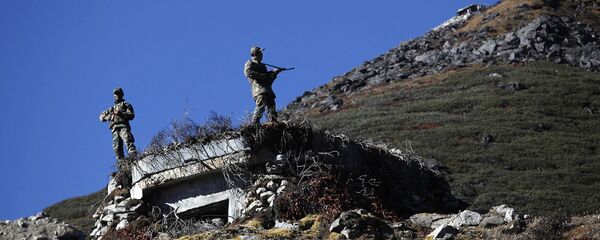Indian army troops and China’s People’s Liberation Army troops have maintained aggressive posturing in the Galwan Valley and Pangong Tso in the Eastern Ladakh region along the loosely demarcated 4,057 km Line of Actual Control since the last week of April. India’s Defence Minister Rajnath Singh on Tuesday accepted publicly that People’s Liberation Army troops had come in large number to the contested site.
In the first week of May, personnel from both sides had engaged in a physical altercation in at least three to four places in the Western Himalayas, resulting in injuries on both sides. Meanwhile, satellite images have shown expanding military presence on both sides with the arrival of new camps and heavy armour in the Galwan Valley.
Indian strategy experts have reiterated that stand-offs between the troops from both sides often occur due to the undefined border and once or twice the stand-off has escalated.
However, Bali R. Deepak, Professor at the Centre of Chinese and Southeast Asian Studies at Jawaharlal Nehru University, says: “We have seen that various mechanisms that India and China have established between 1993 and 2013 but have failed to check the occurrence of such standoffs. There cannot be a military solution either.”
The right thing for both the countries to do right now in order to de-escalate the situation, Bali says “rather than flaring up jingoism, both India and China must go back to the consensus reached in Wuhan and later in Mahaballipuram, reactivate all available confidence-building mechanisms and restore the status quo ante.”
In April 2018 at an informal Wuhan Summit, Indian Prime Minister Narendra Modi and China Xi Jinping issued a strategic guidance for their armies to “strengthen communication in order to build trust and mutual understanding and enhance predictability and effectiveness in the management of border affairs”.
India-China Boundary like Parallel Lines
Calling the traditional and customary boundary lines claimed by India and China as two parallel lines that will never converge, Bali explains that “if the Indian side asserts that the official Chinese maps of 1893, 1917 and 1919 showed the customary boundary exactly as depicted in official maps of India today, China will be quick to add that the Indian maps of 1938 published by the Survey of India and even 1951 edition of Nehru’s Discovery of India, which did not show the McMahon Line”.
The McMohan line, which is the effective boundary between China and India and similar to the Line of Actual Control, was drawn between Colonial India, China and Tibet in 1914 at the Simla Convention. However, Beijing does not recognise it as it considers Tibet to be part of China.
Land Swap Deal
Bali dismisses the idea of LAC being the definite border between the two countries by saying a “big no” to it. The professor proposed that finding the solution on the basis of the “package deal” offered by first Premier of the People's Republic of China Zhou Enlai to India in 1960 would be an ideal proposition.
Explaining the "package deal", former Chinese Ambassador to India Cheng Ruisheng had said: "As per the Zhou’s proposal, in the Eastern sector, China would have agreed to accept the Himalayas as border between the Asian giants and hand over 90,000 square kilometers of disputed land to India, making a major compromise. In the Western sector the, proposal was India would have had to agree to Karakoram as a border between India and China, and compromise handing over 33,000 square kilometers of land to China".
Bali says ‘package deal’ remains the best possible solution to bury the hatchet and rebalance the India-China relationship geared towards the changing of power dynamics in the region as well as the world.
He further suggests conducting joint surveys and demarcating the entire border on the ground, which will be “the third step of the resolution as advocated by the Special Representatives of India and China”.
Question of Demilitarising the Borders
The usual confrontations between Indian and Chinese troops in the no man’s land in different sectors and the 73-day Doklam stand-off have indicated the utility of demilitarising the border in order to maintain peace and stability along with preventing such tensions.
While the professor has stated the importance of drawing a definite border to end the conflict between two countries, he believes that “demilitarisation at this stage will not help, as India believes that it won't be rooted in the concept of equal and mutual security.”
While China had built military infrastructure along the Line of Actual Control long ago, India has expedited the infrastructure works in the last 10-12 years.
“As the Chinese claim the line has been changing in the Western sector, there is no guarantee that the Chinese will not move in and alter the status quo again. Therefore, at this point in time, since China has the upper hand, she will perhaps not go for the resolution of the border issue; as has been done in the South China Sea, the same could be replicated along the LAC, i.e. reclaim the areas, place the military there and pass it on as fait accompli,” Bali said.








